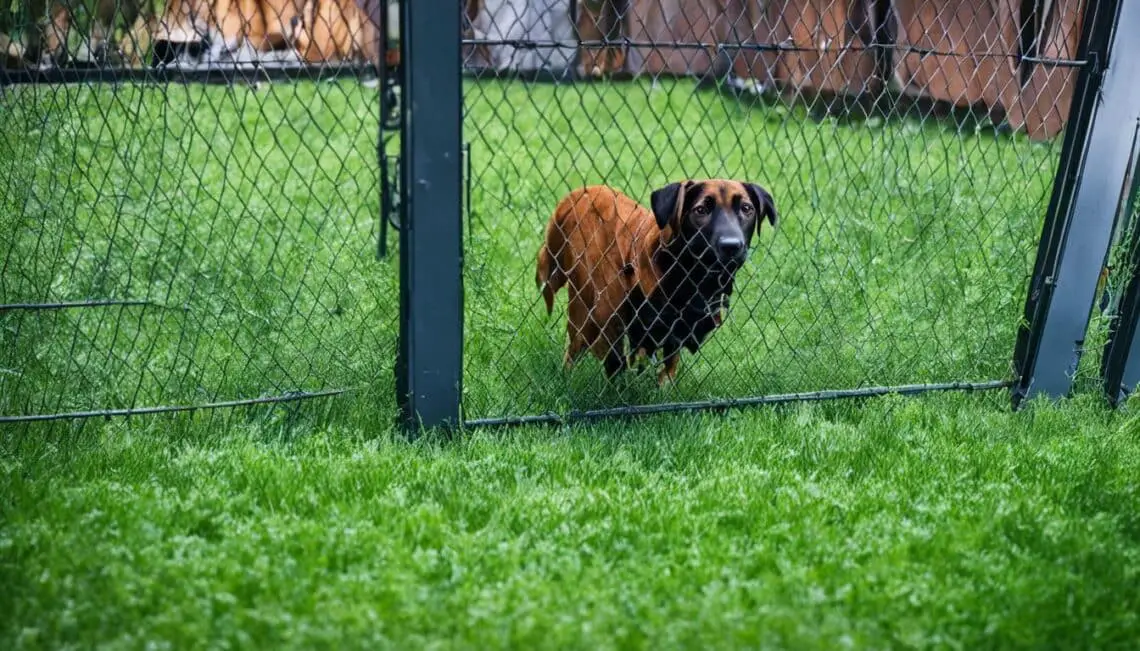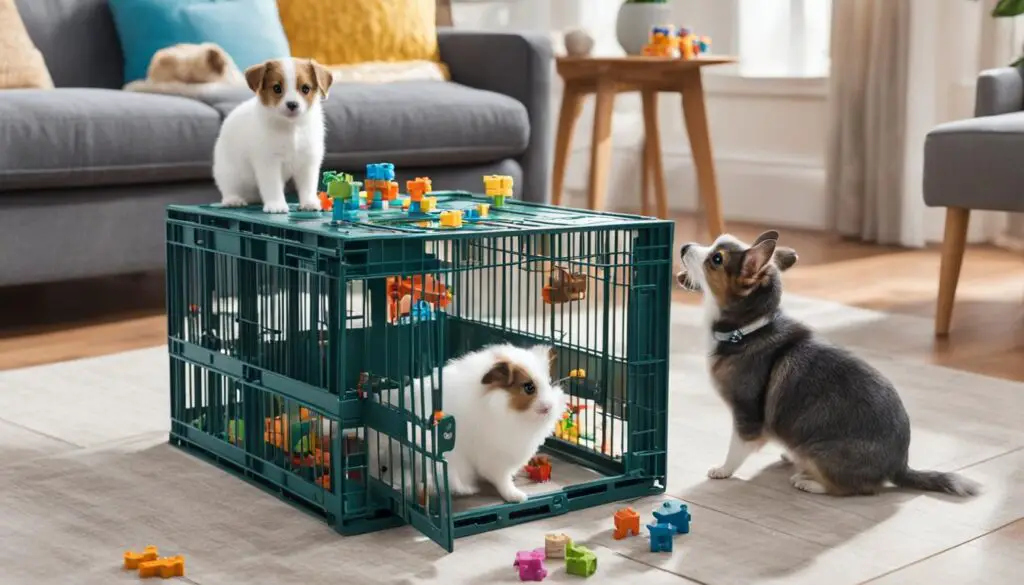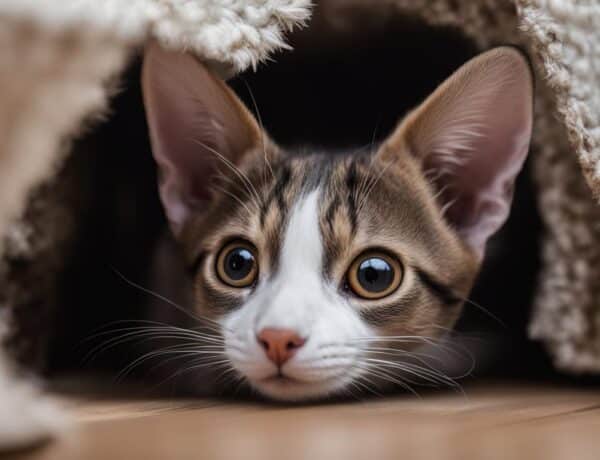As a pet owner, I understand the challenge of keeping intelligent small pets from attempting to escape. Whether it’s a clever dog or a curious cat, their determination to explore can sometimes lead to dangerous situations. That’s why it’s crucial to have smart strategies in place to prevent escape attempts and ensure the safety of our beloved furry friends.
One of the first steps in preventing escape attempts is to choose a high-quality crate that is appropriate for your pet’s size and temperament. Investing in a secure crate can help deter even the most intelligent pets from getting out. However, it’s not just about the crate itself; proper crate training is key.
By crate training your pet and providing positive associations with their crate, you can create a safe and comfortable space that they won’t want to escape from. Understanding the reasons behind their escape attempts is also vital. Dogs, for example, may try to break free due to separation anxiety or a strong desire to protect their territory.
Key Takeaways:
- Choosing a high-quality crate is essential for preventing escape attempts.
- Proper crate training and positive associations can discourage pets from wanting to escape.
- Understanding the underlying reasons for escape attempts helps find effective solutions.
- Addressing separation anxiety and territorial instincts can reduce escape incidents.
- Investing in additional security measures, like extending fences, can further prevent escapes.
The Importance of Choosing the Right Crate
Not all crates are created equal. It’s crucial to choose a crate that is appropriate for your pet’s size and needs.
When it comes to preventing escapes, wire crates and thin plastic crates may not be suitable for all dogs, especially those prone to escaping. These crates can be easily damaged or broken by an intelligent small pet determined to make a getaway.
Instead, consider investing in a heavy-duty crate that is designed to keep your clever companion secure. These crates are made with stronger materials and reinforced construction, making them more escape-proof. They provide an extra layer of protection for pets who are determined to test the limits of their confinement.
When selecting a crate, take into account the intended use and your pet’s temperament. Some crates are better suited for home use, while others are designed for travel. Additionally, consider your pet’s size, strength, and any specific behaviors that may impact their crate experience.
A well-chosen crate will not only prevent escapes but also provide your pet with a comfortable and secure space of their own. It plays a crucial role in their overall well-being by giving them a sense of security and a place to retreat to when they need some peace and quiet.
By choosing the right crate, you can significantly reduce the risk of escape attempts and ensure the safety of your intelligent small pet.
| Wire Crate | Thin Plastic Crate | Heavy-Duty Crate | |
|---|---|---|---|
| Strength | Medium | Low | High |
| Escape-proof | No | No | Yes |
| Durability | Low | Low | High |
| Recommended for | Low-energy pets | Non-escape artists | Escape-prone pets |
Understanding Why Dogs Try to Escape Crates
Dogs can be master escape artists when it comes to crates. There are several reasons why your intelligent small pet may attempt to break free. By understanding these underlying causes, you can address their behavior and find appropriate solutions to prevent future escape attempts.
- Separation Anxiety: Dogs with separation anxiety may frantically try to escape their crates in an attempt to be reunited with their owners. This condition can cause extreme distress and should be approached with patience and compassion.
- Fear: Some dogs may try to escape crates when they feel fearful or threatened. This can be triggered by loud noises, unfamiliar environments, or previous negative experiences.
- Boredom: Intelligent small pets need mental stimulation and physical activity to stay happy and engaged. If your dog is bored and lacks outlets for their energy, they may resort to trying to escape their crate in search of entertainment.
- Mating Instinct: Unneutered male dogs or females in heat may attempt to escape their crates to search for a mate. The strong drive to reproduce can override their desire to stay confined.
It is important to note that each dog is unique, and their motivations for escape attempts may vary. Observing your pet’s behavior and consulting with a professional trainer or veterinarian can provide valuable insights into their specific needs.
“Understanding the reasons why dogs try to escape crates is crucial to effectively addressing their behavior.” – Dr. Samantha Johnson, Animal Behaviorist
The Impact of Traumatic Experiences
Some dogs may have had traumatic experiences in crates, contributing to their heightened escape attempts. Whether it’s a history of abuse or a previous negative confinement, these experiences can lead to extreme separation anxiety, fear, and a desperate desire to escape. Providing a safe and secure environment is essential in helping these dogs overcome their past trauma.
By addressing the underlying reasons behind your pet’s escape attempts, you can take proactive steps towards resolving their behavior and ensuring their safety.
Preventing Escape Attempts: A Comprehensive Approach
Preventing escape attempts by intelligent small pets involves a multifaceted approach that considers both their physical and psychological needs. Here are some strategies to consider:
- Invest in a sturdy and escape-proof crate that is appropriate for your pet’s size and strength.
- Ensure your pet receives regular exercise, mental stimulation, and social interaction to combat boredom.
- Address separation anxiety through gradual desensitization and counterconditioning exercises.
- Explore alternative confinement options, such as a securely fenced yard or a dedicated dog-proof room.
- Implement positive reinforcement training techniques to encourage desirable behaviors and strengthen the bond with your pet.
Remember, preventing escape attempts requires patience, consistency, and understanding. Seek guidance from a professional if you’re encountering significant challenges in addressing your pet’s behavior.
| Reasons for Escape Attempts | Preventive Measures |
|---|---|
| Separation anxiety | Gradual desensitization, counterconditioning exercises |
| Fear | Crate training, creating positive associations, providing a safe and comforting environment |
| Boredom | Regular exercise, mental stimulation, interactive toys |
| Mating instinct | Spaying/neutering, responsible breeding practices |
Strategies for Preventing Escape Attempts
When it comes to intelligent small pets, preventing escape attempts requires a multi-faceted approach. Here are some strategies you can implement to keep your furry friends safe and secure:
1. Keep Your Pet Engaged and Mentally Stimulated
Intelligent pets need mental stimulation to prevent boredom and the urge to escape. Provide them with interactive toys, puzzle games, and regular exercise to keep their minds occupied. Additionally, social interaction with you and other pets can help alleviate their need for exploration.
2. Establish a Safe and Secure Yard Space
Creating a safe and secure space within your yard is crucial. Consider installing a sturdy kennel or dog house that is escape-proof and can provide shelter. Ensure the area is properly enclosed and free from any hazards that may prompt your pet to attempt an escape.
3. Train Your Pet with Obedience Commands
Teaching your pet basic obedience commands can make a significant difference in preventing escape attempts. Commands like “sit,” “stay,” and “come” can help you maintain control and redirect your pet’s focus in situations where they may feel the need to escape.
4. Desensitize Them to Anxiety Triggers
If your pet has specific triggers that induce anxiety and lead to escape attempts, work on desensitizing them to those triggers. Gradually expose your pet to the triggering stimuli in a controlled environment and reward them for calm behavior. This process can help reduce their anxiety levels and decrease the likelihood of escape.
5. Implement Additional Security Measures
To enhance the security of your yard and prevent escape, consider installing additional measures such as extending existing fences, adding coyote rollers, or using underground electric fencing. Consult with a professional to determine the most suitable security options for your specific needs.
By taking a proactive approach and combining these strategies, you can minimize the risk of your intelligent small pet attempting to escape their environment.
What to Do When Your Pet Escapes
If your pet does manage to escape, it’s important to stay calm and take immediate action. Here are some steps you can take to increase your chances of finding your beloved pet:
1. Search Your Immediate Area
Start by searching your immediate surroundings, including your yard, nearby bushes, and hiding spots. Call out your pet’s name and listen for any signs of movement or barking. It’s also helpful to carry their favorite treats or toys to attract their attention.
2. Alert Your Neighbors
Inform your neighbors about your missing pet and provide them with a description. They can keep an eye out for your furry friend and notify you if they spot them. Take advantage of your community’s support to maximize your chances of a safe return.
3. Check Nearby Animal Shelters
Contact local animal shelters and provide them with a detailed description of your pet. Visit the shelters in person and check their lost and found sections regularly. Leave your contact information with each shelter so they can reach out to you if your pet is found.
4. Organize a Search Party
If your search efforts have been unsuccessful, consider organizing a search party in your neighborhood. Rally friends, family, and fellow pet owners to assist you in finding your lost pet. Assign different areas to search and coordinate regular updates to cover as much ground as possible.
5. Utilize Social Media and Signs
Utilize the power of social media to spread the word about your missing pet. Create a post with a clear photo, detailed description, and contact information. Encourage friends and followers to share your post to reach a wider audience. You can also put up signs in your neighborhood with your pet’s photo and your contact details.
6. Invest in GPS Tracking
Consider equipping your pet with a GPS tracking collar or implanting a microchip. These devices can significantly increase the chances of finding your pet if they escape in the future. Always ensure your contact information is up to date so that anyone who finds your pet can easily reach you.
Remember, it’s important never to punish your pet for escaping, as this may lead to anxious behavior and further attempts to escape. Stay positive, persistent, and hopeful during your search, as many pets have found their way back home with the help of determined pet owners and supportive communities.
Conclusion
Preventing escape attempts by intelligent small pets requires a thoughtful approach that combines strategies and understanding of their individual needs. By selecting the right crate, addressing the underlying reasons for escape attempts, and implementing effective preventive measures, you can ensure the safety and security of your clever companions.
When choosing a crate, opt for a high-quality and secure option that is appropriate for your pet’s size and temperament. This will significantly reduce the chances of escape. Additionally, take the time to crate train your pet properly, using positive reinforcement to create a positive association with their crate.
It’s crucial to prioritize your pet’s physical, mental, and emotional well-being. Engage them with toys, regular exercise, and social interaction to keep them mentally stimulated and content. Create a safe and secure space in your yard, such as a kennel or dog house, to provide them with a designated and comfortable area.
If escape attempts persist, consider seeking professional help to address any underlying behavioral issues. By understanding the reasons behind your pet’s escape attempts, you can implement appropriate training and behavior modification techniques to deter future incidents. Remember that punishment is not an effective solution and can worsen the situation.
With the right approach, you can effectively prevent escape incidents and provide a secure environment for your intelligent small pets. By investing time and effort into their well-being, you’ll enjoy a strong bond and a peaceful coexistence with your clever companions.
FAQ
What kind of crate should I choose for my intelligent small pet?
It’s important to choose a high-quality crate that is appropriate for your pet’s size and temperament. Consider investing in a heavy-duty crate designed to keep intelligent small pets secure.
Why do dogs try to escape crates?
Dogs may try to escape crates due to factors such as separation anxiety, fear, boredom, or the mating instinct.
How can I prevent escape attempts by my intelligent small pet?
You can prevent escape attempts by keeping your pet mentally stimulated, providing a safe and secure space, training them with basic obedience commands, and implementing additional security measures.
What should I do if my pet manages to escape?
If your pet escapes, stay calm and take immediate action by searching your immediate area, alerting your neighbors, checking nearby animal shelters, and utilizing social media to spread the word. Consider investing in a GPS tracking collar or microchip implant for future prevention.
How can I ensure the safety and security of my intelligent small pet?
By choosing the right crate, understanding the reasons for escape attempts, implementing preventative measures, and prioritizing your pet’s physical, mental, and emotional well-being, you can provide a secure environment for your intelligent small pet.







No Comments